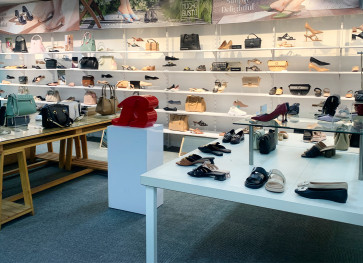New station facilities trouble pedestrians
Going up: A commuter climbs steps leading to Palmerah station in West Jakarta
Change Size
 Going up: A commuter climbs steps leading to Palmerah station in West Jakarta. A number of passengers have complained that the stationâs stairs are not friendly for disabled or elderly people or pregnant women.(JP/AWO) (JP/AWO)
Going up: A commuter climbs steps leading to Palmerah station in West Jakarta. A number of passengers have complained that the stationâs stairs are not friendly for disabled or elderly people or pregnant women.(JP/AWO) (JP/AWO)
G
span class="inline inline-center">Going up: A commuter climbs steps leading to Palmerah station in West Jakarta. A number of passengers have complained that the station's stairs are not friendly for disabled or elderly people or pregnant women.(JP/AWO)
Ghufron, 70, and his wife Dian stopped to catch their breath as they climbed the stairs of Palmerah train station in West Jakarta. They were accessing the second floor where passengers can buy tickets before going back downstairs to the platform on the first floor.
'I don't have a problem climbing these stairs, however, my wife is struggling,' Ghufron told The Jakarta Post recently.
Ghufron, who planned to visit family members in Serpong, South Tangerang, said he hoped that the train station could be made more friendly for elderly people like him and his wife, so they could still ride the train comfortably in the future.
'We live nearby, so it will be ridiculous if we have to take the train from a different station just because we cannot use the stairs,' he said.
Despite an improved service, some aspects of Jakarta's new train stations, including pedestrian bridges, have attracted complaints from passengers as they have been forced to walk longer and climb further.
Palmerah station, for example, has a new elevator to ease access for passengers but sometimes it does not work. It also has a pedestrian crossing, which was active before the completion of the pedestrian bridge. Nowadays, the pedestrian crossing is barely used as the station gate it leads to has been closed.
Annisa Rahmalia, a regular train commuter who travels from her house in Bogor, West Java, to West Jakarta, could not hide her dismay when talking about the new exit gate in Bogor train station.
Although she said she appreciated the general improved service and facilities offered by PT Kereta Api Indonesia (KAI), she called the new exit gate obnoxious.
'It is so far now to get out of the station area to the nearby street,' she said.
Annisa said she was also upset with the design of the new crossing bridge at the station, which was not ergonomic.
'The steps of the stairs are very shallow and the staircase itself is narrow and very steep. The facility should make passengers' lives easier, not harder,' she said, adding that using the bridge was uncomfortable, especially during rush hour.
Despite the Bogor city administration's claim that the crossing bridge would reduce jaywalking and congestion, Annisa said the traffic jam in front of the station remained the same.
'It is still congested as many angkot [public minivans] still stop randomly to wait for passengers,' she said.
Pedestrian Coalition chairman Alfred Sitorus said that his coalition had urged the Bogor city administration and other local governments to halt the construction of pedestrian bridges.
'Most stairs to the bridges are too steep, so they cannot accommodate all ages and abilities,' he said.
He added that the pedestrian bridges were often walled in by banners and billboards leaving users vulnerable to theft and sexual assaults. He said it would be better to provide a proper pedestrian crossing as they were more passenger friendly.
Alfred also pointed out the lack of integration between stations and surrounding pedestrian facilities, including at Gondangdia Station in Central Jakarta, which is one of the busiest stations in the area as it is close to many government and private offices.
'However, no proper sidewalks are provided within a radius of 1 to 2 kilometers of the station. It makes people hate walking and eventually makes people opt to take an ojek [motorcycle taxi],' he said.
He also criticizes the long fence that forces passengers to walk further. The fence was aimed at solving congestion in front of the station, caused by crowds of ojek drivers waiting for passengers.









